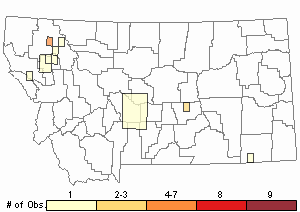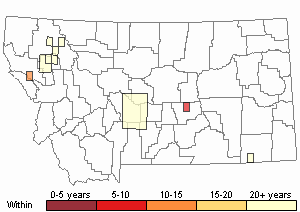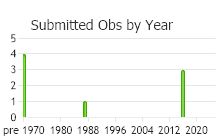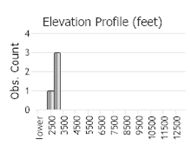View in other NatureServe Network Field Guides
NatureServe
Montana
Utah
Wyoming
Idaho
Wisconsin
British Columbia
South Carolina
Yukon
California
New York
A Lime Moss - Didymodon fallax
General Description
Plants: Acrocarpous. Growing in crowded large patches or cushions (Lawton 1971), green to russet. Stems sometimes reaching 25 mm in height; possessing a central strand; hairs of the leaf axil ca 5 cells long, the first 1 or 2 cells brown (FNA 2007).
Leaves: Upright and close to the stem to spreading slightly when dry, spreading, sometimes also curved back and downward distally and keeled when damp, 0.6-2.5 mm in length, deltoid with ovate tendencies to lance-shaped, tapering to a somewhat narrowly-angled and non-deciduous apex; margins smooth, at mid-leaf almost flat to curved back and downward; costa narrowing and much wider at the bottom than apically, extending shortly beyond the leaf tip, typically as a mucro with papillae (FNA 2007).
Leaf Cells: Upper laminal cells isodiametric, smooth or with 1-3 papillae, in 1 cell-layer; proximal laminal cells square or short-oblong; costa with elongate ventral cells, in X-section with 1 row of guide cells (FNA 2007), a ventral stereid band (Crum & Anderson et al., 1981), and a prominent abaxial stereid band (Lawton 1971).
Phenology
Fruit may ripen any time of year (FNA 2007).
Diagnostic Characteristics
Didymodon vinealis has a similarly grooved costa, but the superficial ventral cells of its costa are square or nearly so rather than elongate as in D. fallax (FNA 2007).
Merging somewhat with Didymodon ferrugineus, but the leaves of D. ferrugineus are typically wider and the papillae are often large and more noticeable; the sporophytes of D. ferrugineus are also similar but typically smaller (FNA 2007).
Range Comments
North American Range
AK to NL and NS, CA, ID to ND, UT, NM, KS, TX, extending to the eastern coastal states from MN s to MO, also TN and AL; Mexico (FNA 2007). Known in Montana from Flathead, Glacier, Granite, Lake, and Powder River Counties (Elliott & Pipp, 2016).
Observations in Montana Natural Heritage Program Database
Number of Observations: 18
(Click on the following maps and charts to see full sized version)
Map Help and Descriptions
Relative Density

Recency



 (Observations spanning multiple months or years are excluded from time charts)
(Observations spanning multiple months or years are excluded from time charts)
Habitat
Damp to wet calcareous soil (Crum & Anderson et al., 1981) of varying textures, from silt to sand or conglomerate, stone, concrete structures (FNA 2007), often pioneering disturbed areas, such as road embankments (Crum & Anderson et al., 1981). Elevation: 660-10,830 feet (FNA 2007).
Reproductive Characteristics
Dioicous. Sporophytes common (Crum & Anderson et al., 1981). Perichaetia occurring at the stem apices (FNA 2007). Seta red (Crum & Anderson et al., 1981), 6-12 mm tall. Capsule 0.8-1.5 mm in length (FNA 2007), brown, upright or nearly so, straight (Lawton 1971); peristome with 16 very slender teeth split nearly to their bottom and spiraled anti-clockwise 1 or 2 times (FNA 2007).
No specialized vegetative reproduction (FNA 2007).
Stewardship Responsibility
References
- Literature Cited AboveLegend:
 View Online Publication
View Online Publication Crum, H.A. and L.E. Anderson. 1981. Mosses of Eastern North America. 2 volumes. Columbia University Press, New York. 1328 pp.
Crum, H.A. and L.E. Anderson. 1981. Mosses of Eastern North America. 2 volumes. Columbia University Press, New York. 1328 pp. Elliott, J.C. and A.K. Pipp. 2018. A Checklist of Montana Mosses (1880-2018). Updated 3 January, 2020. Montana Natural Heritage Program, Helena, Montana. 73 pp.
Elliott, J.C. and A.K. Pipp. 2018. A Checklist of Montana Mosses (1880-2018). Updated 3 January, 2020. Montana Natural Heritage Program, Helena, Montana. 73 pp. Flora of North America Editorial Committee, eds. 2007. Flora of North America North of Mexico. Volume 27. Bryophytes: Mosses, Part 1. Oxford University Press, Inc., NY. xxi + 713 pp.
Flora of North America Editorial Committee, eds. 2007. Flora of North America North of Mexico. Volume 27. Bryophytes: Mosses, Part 1. Oxford University Press, Inc., NY. xxi + 713 pp. Lawton, E. 1971. Moss Flora of the Pacific Northwest. Hattori Botanical Laboratory. Japan: Yamabuki-cho, Shinjuku-ku, Tokyo. 362 pages plus appendices.
Lawton, E. 1971. Moss Flora of the Pacific Northwest. Hattori Botanical Laboratory. Japan: Yamabuki-cho, Shinjuku-ku, Tokyo. 362 pages plus appendices.
- Additional ReferencesLegend:
 View Online Publication
View Online Publication
Do you know of a citation we're missing? Elliot, J. C. 1993. Second checklist of Montana mosses. Unpublished report. U.S. Forest Service, Region 1. Missoula, MT. 45 pp.
Elliot, J. C. 1993. Second checklist of Montana mosses. Unpublished report. U.S. Forest Service, Region 1. Missoula, MT. 45 pp. Flowers, S. 1973. Mosses: Utah and the West. Brigham Young University, Provo, Utah. 567 p.
Flowers, S. 1973. Mosses: Utah and the West. Brigham Young University, Provo, Utah. 567 p. Lawton, E. 1971. Keys for the Identification of the Mosses on the Pacific Northwest. Reprinted from 'Moss Flora of the Pacific Northwest'. Published as Supplement No. 2 of the Journal of the Hattori Botanical Laboratory. Nichinan, Miyazaki, Japan. 66 pp.
Lawton, E. 1971. Keys for the Identification of the Mosses on the Pacific Northwest. Reprinted from 'Moss Flora of the Pacific Northwest'. Published as Supplement No. 2 of the Journal of the Hattori Botanical Laboratory. Nichinan, Miyazaki, Japan. 66 pp. Malcolm, B., N. Malcolm, J. Shevock, and D. Norris. 2009. California Mosses. Nelson, New Zealand: Micro-Optics Press. 430 pp.
Malcolm, B., N. Malcolm, J. Shevock, and D. Norris. 2009. California Mosses. Nelson, New Zealand: Micro-Optics Press. 430 pp. Smith, A.J.E. 1980. The Moss Flora of Britain and Ireland. Cambridge University Press, Cambridge. 705 pp.
Smith, A.J.E. 1980. The Moss Flora of Britain and Ireland. Cambridge University Press, Cambridge. 705 pp.
- Web Search Engines for Articles on "A Lime Moss"





